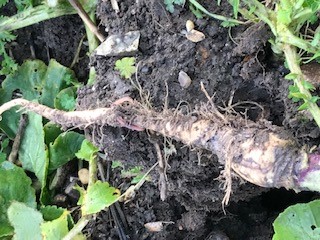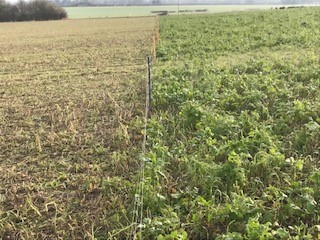Caring for the earth
Having “good” soil can improve plant health and vigour, promote the ecosystems that live within it and increase carbon sequestration. All of this helps support the growth of food crops and a greener environment for everyone to enjoy.
What’s our soil like?
Monitoring and managing soil health is an ongoing process, but first we need to understand what we’re working with. At Earth Trust we’re in the process of analysing our Farm soils to get an indication of their health and chemistry. This includes looking at Soil Organic Carbon (SOC), which is a complex mixture of the organic material found in the soil. SOC is an important indicator of soil health, as it affects its water-holding capacity and increases the cycling of nutrients by providing slow-release energy for soil microorganisms.
The analysis will also tell us the phosphate, potash and sulphur levels in the soil, which are all critical nutrients for plant growth and health. And the healthier they are, the less prone they are to pests and diseases, reducing the need for additional controls which all add to the cost of production.
pH analysis is another key part of this process to find out how acidic or alkaline the soil is (on a scale of 1-14, a low number indicates an acidic soil, and a higher number indicates more alkaline conditions). If the pH is out of balance, nutrients can become “locked-up” in the soil as plants struggle to access them, even where nutrients have been added through a mulch or fertiliser.
The ideal pH varies for different plants – most cereal crops need a pH range of 6.5-7.5, while ericaceous plants like camellias or blueberries prefer a more acidic soil. Once we have information about the current pH levels of the soil, we can rectify them if needed. This is usually done by adding substances to the soil, such as lime to make the soil more alkaline or sulphur to make it more acidic.
Try it at home
If you’re a keen gardener you can do these tests on your own soil at home, but first it can be useful to understand what kind of soil you have. You can also do a worm count to see how healthy it is – the more worms you have, the healthier your soil is likely to be.
How to check your soil type:
Gardener’s World – find out your soil type
RHS – soil types
Soil Association – Earthworms: Soil Engineers (video)
Managing soil health on the Earth Trust Farm
As well as crop rotations, we also utilise “cover crops” wherever we can, which are planted in between the growing seasons of our “cash crops” (those that we grow commercially).
Cover crops can improve the biological, chemical and physical properties of soil, and can have a number of benefits, including:
- Reducing water runoff through improved infiltration (movement of water through the soil surface) and percolation (movement of water through the soil profile).
- Storing nutrients until the following years’ cash crop can use them, reducing nutrient runoff and leaching.
- Reducing soil compaction as their deep tap roots penetrate layers of compacted soil.
- Improving soil structure and stability: evapotranspiration (the process of water evaporating from the soil and transpiring from the cover crop plants) reduces moisture levels in the soil, so it’s better able to withstand heavy farm equipment and results in less subsurface compaction.
- Suppressing soil pests and diseases naturally and serving as a mulch, or cover, to suppress weed growth.
- Providing high-quality material for grazing livestock or hay.
- Providing food and shelter for wildlife, including beneficial insects and pollinators.
When a cover crop is managed for its contribution of nitrogen to soil, this also reduces the need to add artificial fertiliser, which is produced using fossil fuels and is expensive to buy.

Radish used as a cover crop, which is great for “pan busting” (breaking up soil compaction) and nutrient retention.

We’re also testing the effects of grazing on cover crops. Above: grazed versus un-grazed areas.
Earth Trust Farm already operates on a “minimum till” basis, and we’re currently taking part in a living mulch trial, too. As we begin to understand more about the soil we care for and the ecosystems that it connects, we’ll be looking at new ways to protect and enhance it. Watch this space!